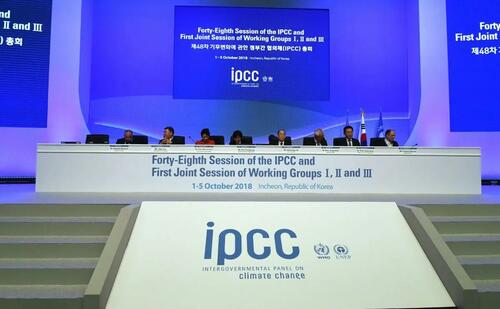by Ella Kietlinska and Jan Jekielek via The Epoch Times (emphasis ours),
An MIT scientist has said that although the global temperature rise owing to a greenhouse effect is real, the increase is small and does not pose any existential threat.
The greenhouse effect is primarily caused by water vapor and clouds, said Richard Lindzen, professor emeritus of atmospheric sciences at Massachusetts Institute of Technology (MIT).
Carbon dioxide (CO2), methane, and nitrous oxide are minor constituents of the greenhouse effect, Mr. Lindzen told EpochTV’s “American Thought Leaders” in an interview.
“If all other things are kept constant, and you double CO2, you would get a little under one degree of warming,” Mr. Lindzen said. Some climate models estimate the highest warming at three degrees, but “even three degrees isn't that much,” he added.
“We're dealing with changes for a doubling of CO2 on the order of between breakfast and lunch,” he said.
According to NASA, the greenhouse effect is "the process through which heat is trapped near Earth's surface by substances known as 'greenhouse gases.' Greenhouse gases consist of carbon dioxide, methane, ozone, nitrous oxide, chlorofluorocarbons, and water vapor.”
Politicians, universities, international organizations, and media have called climate warming an existential threat to humanity.
President Joe Biden said at a press conference in Vietnam in September that, “The only existential threat humanity faces even more frightening than a nuclear war is global warming going above 1.5 degrees in the next ... 10 years.”
The Climate Change Working Group at Western Michigan University has warned that the “global temperature has risen at least 1°C since mid-20th century” and said that “climate change is an existential threat to the quality of life on this planet.”
Bruce Aylward, assistant director General at the World Health Organization (WHO), said in November that climate change poses an existential threat to all people, in particular pregnant women and children.
Mr. Lindzen asserted that calling climate change an existential threat comes from propaganda.
Even the Intergovernmental Panel on Climate Change (IPCC)—the United Nations body for assessing the scientific basis of climate change, its impacts, and options to mitigate—does not call it an existential threat, Mr. Lindzen said.
In its report, the IPCC talks about a reduction in GDP by 3 percent by 2100 owing to climate change, Mr. Lindzen added. “Assuming the GDP has increased several times by then, that doesn't sound existential to most people.”
Extreme Climate Change of the Past
There is also an argument that during major climate changes in Earth’s history, the global mean temperature change was only five degrees, implying that warming by “three degrees could be something serious,” Mr. Lindzen said.
He referred to two climate change events when the mean temperature difference between these two periods and today was only about five degrees.
One of the events was the Last Glacial Maximum, also known as the last ice age, when Illinois was covered with an ice sheet about 2 kilometers (1.2 miles) thick.
“The latest ice age peaked about 20,000 years ago, when global temperatures were likely about 10°F (5°C) colder than today,” the National Oceanic and Atmospheric Administration (NOAA) says.
The second event was the warm period about 50 million years ago when alligator-like creatures were living on Svalbard, a Norwegian archipelago located north of the Arctic Circle.
During this hot period about 55–56 million years ago, the global mean temperature “appears to be” higher than today’s temperature by about seven degrees Celsius (13 degrees Fahrenheit), reaching 73 degrees Fahrenheit, NOAA said.

However, the warming of the last 150 years, since the pre-industrial era (1850–1900), has “no resemblance” to these two major climate changes, Mr. Lindzen said.
During these periods, the temperature in the tropics remained almost constant while the temperature difference between the tropics and the pole increased by 20 degrees Celsius during the Last Glacial Maximum and decreased by 20 degrees Celsius during the warm period, the scientist pointed out.
On the other hand, the temperature increase since the pre-industrial age owing to the greenhouse effect observed today remains the same in every place from tropics to pole, Mr. Lindzen explained.
“The tropics-to-pole temperature difference depends on the dynamics of the heat transport by motion. To some extent, the equator depends on the greenhouse effect," he said.
The increase we are seeing could be attributed to CO2—about a degree—but it is not changing from tropics to pole, Mr. Lindzen asserted, calling the idea that this temperature shift is “existential” and requires massive mitigation “unreasonable.”
Is CO2 Dangerous?
CO2 reduction is “the dream of a regulator,” Mr. Lindzen said. “If you control CO2, you control breathing; if you control breathing, you control everything. So this always is one temptation.”
“The other temptation is the energy sector. No matter how much you clean fossil fuels, they will always produce water vapor and CO2,” Mr. Lindzen explained.
CO2 is being treated as a poison and most people believe that CO2 is dangerous, the scientist continued, but they forget that CO2 is essential.
“The concentration of CO2 in your mouth is about 40,000 parts per million as opposed to 400 outside,” Mr. Lindzen said. A concentration of “5,000 is permitted on a space station.”
“It's partly poisoned—but worse than that—it's essential. If you could get rid of 60 percent of the CO2, we'd all be dead.”
“This is a very strange pollutant; it's essential for plant life," Mr. Lindzen said. “Yet, because it is the inevitable product of fossil fuel burning in the energy sector, it's being attacked.”

Science Is Used to Advance Climate Change Policies
The IPCC produces reports on climate change that are often thousands of pages long. The institution also releases general summaries for policymakers and “iconic statements” that summarize thousands of pages in one sentence, Mr. Lindzen said.
Only the reports produced by the IPCC’s Working Group I are science, Mr. Lindzen asserted. “Everything else is written by government officials and so on, so it's dicey.”
Working Group I is tasked with assessing the physical science of climate change, according to its website.
One of the iconic statements by IPCC asserted that it was “almost certain that most of the climate change—the warming—since 1960 was due to man,” Mr. Lindzen said, explaining that “if it were even all of it, you're talking about a fraction of a degree.”
Yet Sens. John McCain (R-Ariz.) and Joe Lieberman (D-Conn.) considered this conclusion “the smoking gun” and wanted to do something in response, Mr. Lindzen said.
In 2001, Working Group I published a report explaining the scientific basis of the IPCC’s third assessment of past, present, and future climate change. The report stated that the global average earth surface temperature—a combination of near-surface air temperature over land and sea surface temperature—has increased over the 20th century by 0.4 to 0.8 degrees Celsius (0.72 to 1.44 degrees Fahrenheit).
Most of the observed warming over the last 50 years is likely attributable to human activities, in particular “to the increase in greenhouse gas concentrations,” the report said.
The report also provides a projection on the global temperature increase through the end of the 21st century, relative to 1990, based on the simulation of various emissions scenarios developed by the IPCC. Across all simulated scenarios, the lowest estimated temperature increase was 1.4 degrees Celsius (2.52 degrees Fahrenheit), and the highest was 5.8 degrees Celsius (10.44 degrees Fahrenheit).
In response to the report, Mr. Lieberman and the late Mr. McCain proposed “an economy-wide cap-and-trade system” to control emissions of greenhouse gases in the country, according to a 2001 congressional record.
“Given the fact that the United States produces approximately 25 percent of the total greenhouse gases emissions, the United States has a responsibility to cut its emissions of greenhouse gases,” Mr. McCain said in the record. “American companies now face the risk of being left out of the global marketplace to buy and sell emission reductions.”
“The Earth's average temperature can be expected to rise between 2.5 and 10.4 degrees Fahrenheit during the next century,” Mr. Lieberman said in the record, citing the third assessment report. “Such a large, rapid rise in temperature will profoundly alter the Earth's landscape in very practical terms.”
In 2003, both senators introduced the Climate Stewardship Act that would require the reduction of the emissions of six greenhouse gases and create an international system to trade emissions. The legislation did not pass through the Senate despite being reintroduced in 2005 and 2007.
An innocent statement made by scientists can be misrepresented as "catastrophic” by politicians who then provide more funding for the scientific research in that field, which neither the science community nor the U.N. would object to, Mr. Lindzen said.

The IPCC releases scientific assessment reports of climate change every six to seven years.
In 2021, Working Group I released a report presenting the scientific basis of the IPCC’s sixth assessment of climate change.
The likely range of human-induced increase in global surface temperature in 2010–2019 relative to the pre-industrial era was estimated at 0.8 to 1.3 degrees Celsius (1.44 to 2.34 degrees Fahrenheit), the report said.
‘Science Is Never Settled’
"Those who claim that science is settled want to shut off all disagreement because they do not have much to present,” Mr. Lindzen said. “Science is never settled.”
Politicians and non-scientists have often noticed that science has a certain authority with the public, and they want to co-opt it, so they bring in the term "the science,” Mr. Lindzen said. “But that isn't what science is. ... Science is a mode of inquiry," he said.
It is always open to question; it depends on questions and on being wrong, the scientist pointed out. “When you say science cannot be wrong, you've choked off science.”
“Science isn’t a belief structure, it isn't a cult, isn't a religion.”
Today, it is almost impossible to publish a scientific paper that questions global warming, Mr. Lindzen said.
Scientific journals use referees as gatekeepers who can recommend major revisions to a paper questioning the climate narrative, the scientist explained. The revisions keep the author busy for a year, and then the paper gets rejected, he said. “Climate is one of the earliest examples of cancel culture.”
Mr. Lindzen said that he has a list of prominent scientists, such as nature lab directors, heads of weather bureaus or international organizations, who were suppressed starting from the early 1990s.
On the other hand, “the funding for climate in total went up by about a factor of 15,” creating a new community that exists only because of the climate narrative, Mr.Lindzen said. As a result, no one in the mainstream media questions it.
No comments:
Post a Comment
Note: Only a member of this blog may post a comment.